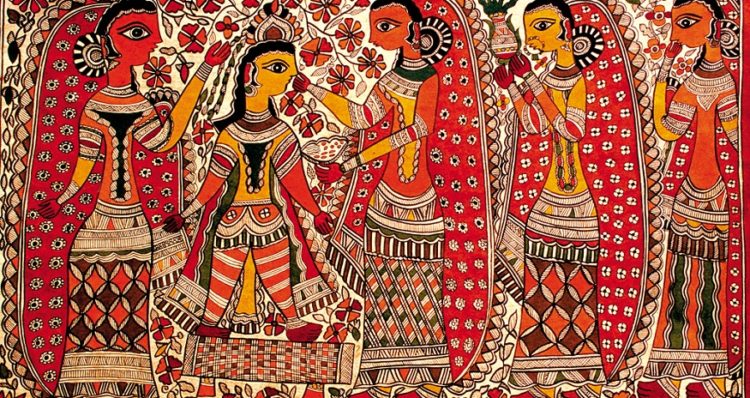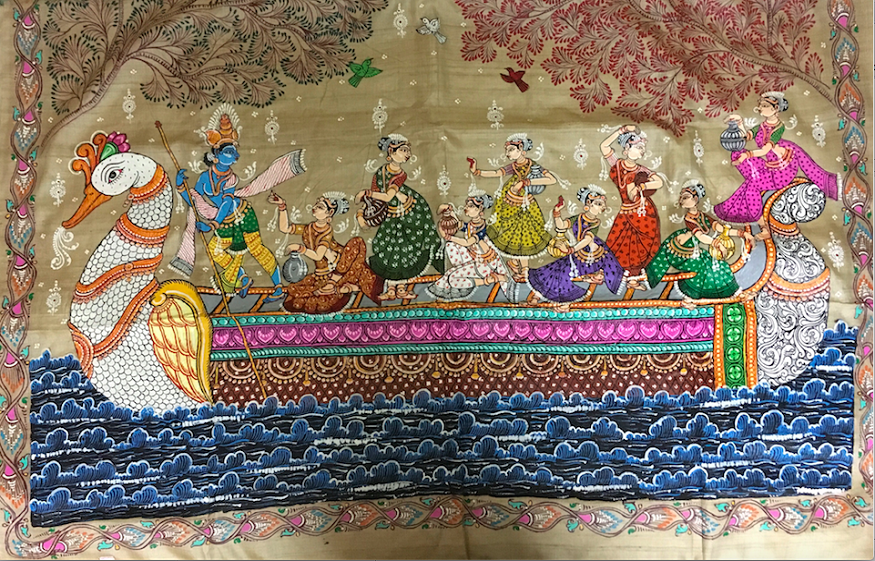
The 5 Most Interesting Facts About Traditional Indian Art
admin | March 24, 2025 | 1 | Lifestyle
Indian art has always been acknowledged with reverence and curiosity. It has been used as a means to depict festivals, culture, religion and different aspects of daily life since the Indus Valley civilization. Not only has it been a source of artistic pleasure, but these paintings are also historical documents that record the daily lives of people from a certain era—their clothing, culture, rituals, architecture, food and much more. There are several types of Indian art that one can acquaint themselves with, ranging from Madhubani and Pattachitra to Mughal and Rajasthani miniature art.
The history of Indian art has been documented by many, but in this article, we’ll be touching upon a slightly different angle—what are the interesting facts about traditional indian art?
Origin
The history of Indian art is not limited to mere decorations. Since ancient times, mankind has been using art to document culture and activities of daily life—be it as hieroglyphics on cave walls or murals. The earliest form of art evolved through Bhittichitra—wall art. To understand what is Indian traditional painting all about, it’s important that we look at the origin of each art form. Different types of traditional Indian art have different histories.
Madhubani art is said to have originated about 2500 years ago when Raja Janak asked the townsfolk of Mithila to decorate the city walls to commemorate Lord Rama and Sita’s wedding. This created a culture of painting house walls, made of mud, with bright colours and auspicious symbols. Similarly, Warli paintings were originally made on brown mud walls with geometric shapes painted in white. However, by the 1970s, they had shifted towards paper canvases.
Pichwai art gets its name from its origin. It was traditionally used to decorate the wall behind the deities at Rajasthan’s Nathdwara temple. You may have heard of Raghurajpur and its residents who earn a living solely by selling Pattachitra paintings. Like Pichwai, they also had a religious purpose as they were used to replace the principal deities of Jagannath temple for a 15-day period. In Bengal, Pattachitra art condensed into a less complex art form—Kalighat art, with fewer, yet prominent characters.
Tools
Now that you’re aware of the history of Indian art, it’s easy to understand that this wasn’t an era of artificial paints and plastic brushes. One of the most interesting facts about traditional Indian art is that it isn’t marred by artificial ingredients. Artists had no other choice but to stick to organic ingredients, and the results were mesmerizing! From extracting colours from leaves and rocks, to making brushes out of animal hair, the history of Indian art is incomplete without talking about the tools used to create these legendary art forms. So, the next time someone asks you, “what are the interesting facts about traditional indian art,” you’ll have your answer ready
To create the canvas for a Pattachitra painting, artists used cotton sarees coated with a paste of soaked tamarind and clay powder. Once left out to dry under the sun, it created a sturdy canvas for the chitrakar to paint on. The handle for paint brushes was made with bamboo while the brush bristles were made with Goat, Squirrel, Horse, Buffalo, Calf and Mouse hair.
The source for paints will give you insights to some of the most interesting facts about traditional Indian art. Pattachitra artists used the gum of Wood Apple (Kaitha) tree as a base for creating different colours. Black colour was made with lamp soot, white from powdered conch shells, orange from the Gerua stone, green from Hyacinth leaves, red from the Hingula rock and violet from Blackberries. Madhubani artists are believed to have derived yellow colour by adding turmeric to the milk of Banyan leaves. One of the most fascinating facts about traditional Indian art is that a Madhubani painting was traditionally made on a canvas created with multanimitti, neem juice and cow dung.
Social function of art
If you’re thinking about what arethe interesting facts about traditional Indian art, history is not the only aspect on the list. Genres like Madhubani art, Pattachitra art, Pichwai art, Mughal Art and Rajasthani art continue to remain relevant because their subject matter has evolved along with time. As immersive as the history of Indian art may be, to stay relevant, one has to stay updated with current social issues. For instance, in a bid to protect a five kilometre long green patch in Bihar, Madhubani artists painted tree trunks with images of deities and religious symbols to prevent them from being cut down. Several Madhubani paintings have garnered international fame due to their treatment of social issues like women’s rights, etc.
In the war against coronavirus, different types of Indian traditional art have also stepped forth to make an impact with modern depictions showing mask-clad figures dressed in traditional attire on a canvas of Phad paintings or Pattachitra art. While the history of Indian art has made it what it is today, these modern innovations are what will keep these art forms alive for generations to come.
Narrative and Performative history

One of the most important facts about traditional Indian art is that most art forms have had a narrative or performative history. Be it cave paintings that narrated the stories of a generation or an elaboratePattachitra painting narrating folk tales, the history of Indian art has been riddled with telling stories.
According to historical records, Pattachitra art began as a profession dating back to the 10th and 11th century A.D. Scroll painters, also known as Patuas, would be invited by wealthy households to recite folktales. They would carry along hand printed scrolls, which depicted mythological tales. The Patuas would narrate these tales, supplemented by songs and hand gestures. Kerala also has a specialty when it comes to performative types of traditional Indian art. In Kalampattu, elaborate images are drawn on the floor using five colours, followed by an auspicious performance.
Modernization of Indian Art
If you ask someone, “What is Indian traditional painting?,” they’ll probably show you an elaborate canvas of intricate artworks. However, neither does everyone have the space for these massive artworks, nor are they interested in an artwork filled with the same stories and symbols as others. The history of Indian art has set certain themes and motifs to express an idea or emotion, but who has stopped us from innovating then into something that suits modern palates?
Various types of traditional Indian art have found expression beyond temple walls and ornate canvases. While Raghurajpur may be home to the traditional patta painting, residents also sell trinkets in the form of stone carvings, palm leaf pattachitra engravings, coconut shell carving, etc. These small scale renditions of Pattachitra art are more accessible and easier to store and use, since they don’t take up a lot of space to be displayed. Today, Pichwai art is no longer restricted to temple walls and adorns the walls of homes and offices. You can also find them on cushion covers, coasters, carpets, etc. The traditionally elaborate Pichwai portrait canvas may have been scaled down, but this doesn’t diminish the beauty of this art form at all.


